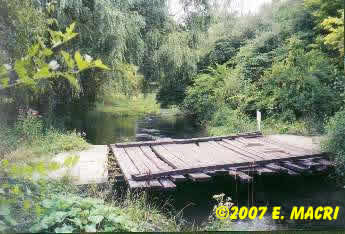The Ecology of a Spring Creek
by
Eugene Macri Jr.
You may use these articles. You can store them. You can read them. You may not change,
republish, sell or redistribute these articles in anyway for any monetary gain. You may not add them to your
collection and sell them etc. These articles are copyrighted and we will strictly enforce the
copyright.
© 2010 E. P. Macri Jr.
Spring creeks are different than other streams. Limestone spring creeks are more different
than most. The state of Pennsylvania is blessed with a number of limestone spring creeks but you would
never know it by the lack of care and protection both the DEP and Pennsylvania Fish and Boat Commission have
given them. Unfortunately, too many fly anglers and even some biologists don't quite understand them.
T hey wish to modify them to some model that exists in a photo or whatever
they have in their head because many spring creeks don't resemble the prototypical trout stream they
understand. In England and some other places the greatest limestone spring creeks often called
English Chalkstreams are manicured and mostly private. In the US we treat them like we do most of
our waters by dumping just about anything imaginable into the streams and aquifers and urbanizing them to
meet our needs. Limestone spring creeks are magic places something out of Excalibur where trout
will often grow large and rise to minute flies to test the skill of the greatest fly anglers. (photo shows the Letort at Bonny Brook; ©2007 E. Macri) hey wish to modify them to some model that exists in a photo or whatever
they have in their head because many spring creeks don't resemble the prototypical trout stream they
understand. In England and some other places the greatest limestone spring creeks often called
English Chalkstreams are manicured and mostly private. In the US we treat them like we do most of
our waters by dumping just about anything imaginable into the streams and aquifers and urbanizing them to
meet our needs. Limestone spring creeks are magic places something out of Excalibur where trout
will often grow large and rise to minute flies to test the skill of the greatest fly anglers. (photo shows the Letort at Bonny Brook; ©2007 E. Macri)
The Pennsylvania limestone spring creeks of Cumberland and Franklin Counties have a number of
similarities:
-
They are low gradient streams at the bottom of valleys
-
They all have a similar biogeochemistry
-
They have a very narrow cold temperature range of around 46 to 52 f.
-
They are small to medium size streams
-
They have similar types of substrates
-
They have similar types of water plants
-
They have nearly identical macroinvertebrate communities
-
They had at one time wild native strains of trout
-
The fish in the streams all were fairly difficult to catch and sophisticated compared to their
freestone cousins
-
Most of the time these streams have very stable flows and volume of water
-
Most do not have a genuine flood plain as compared to freestone streams
-
The fish grow all year long
-
They had an abundance of macroinvertebrates
-
They all suffer from similar environmental problems including sedimentation, pesticides, development
and aquifer withdrawal.
-
Many of the insect populations in the stream had long emergence periods as compared to the same insects
in nearby freestone streams.
-
Because of the narrow temperature range, narrow substrate parameters, and current velocities this
limits the diversity of these ecosystems but allows for the increasing of few populations to very large
sizes that can exploit these niches.
-
Spring creeks are controlled by sunlight. These stream need a lot of light and addition of too
many trees and additional cover will actually limit productivity on these streams
-
The trout in these streams become especially difficult because many of the things they feed upon have
long emergence periods which allow the fish to get a very good light pattern of what they are
eating.
So there you have it in a nutshell some of the most important characteristics of spring creeks in
terms of ecology. The environment shapes the trout and as Charlie Fox put it, "these
streams forced the fly fisherman to evolve or he wouldn't catch any fish. These
streams made the fly fisherman. These streams made fly fishing what it is today!"
| 
 hey wish to modify them to some model that exists in a photo or whatever
they have in their head because many spring creeks don't resemble the prototypical trout stream they
understand. In England and some other places the greatest limestone spring creeks often called
English Chalkstreams are manicured and mostly private. In the US we treat them like we do most of
our waters by dumping just about anything imaginable into the streams and aquifers and urbanizing them to
meet our needs. Limestone spring creeks are magic places something out of Excalibur where trout
will often grow large and rise to minute flies to test the skill of the greatest fly anglers. (photo shows the Letort at Bonny Brook; ©2007 E. Macri)
hey wish to modify them to some model that exists in a photo or whatever
they have in their head because many spring creeks don't resemble the prototypical trout stream they
understand. In England and some other places the greatest limestone spring creeks often called
English Chalkstreams are manicured and mostly private. In the US we treat them like we do most of
our waters by dumping just about anything imaginable into the streams and aquifers and urbanizing them to
meet our needs. Limestone spring creeks are magic places something out of Excalibur where trout
will often grow large and rise to minute flies to test the skill of the greatest fly anglers. (photo shows the Letort at Bonny Brook; ©2007 E. Macri)